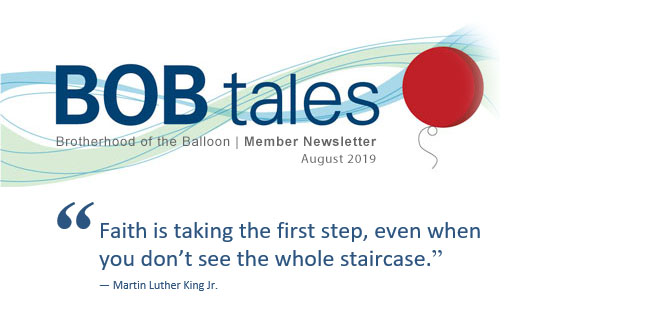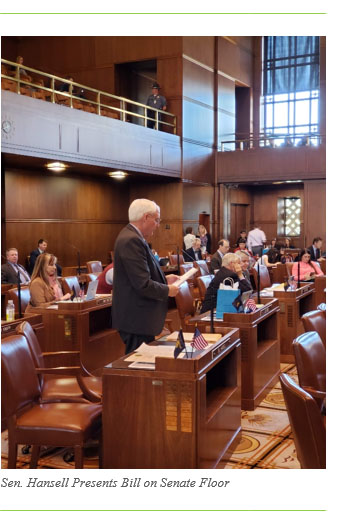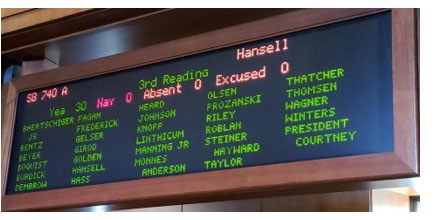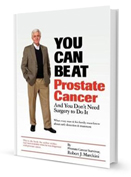
Dear Members (a note from Deb Hickey):
Five years ago, this month, I sat with my husband Mark in his oncologist’s office, fighting back tears, my heart pounding. I vividly remember Dr. Friedman rotating his computer monitor around so we could see what he was looking at—CT imaging of Mark’s abdomen following his final chemotherapy treatment.
-----------------------
Five months earlier, Mark had been diagnosed with stage IV pancreatic neuroendocrine carcinoma with metastasis to his liver. We were told it was terminal and he had months to live—a year if we were “lucky.” I remember the pre-treatment scan—I saw a tennis ball-sized tumor on his pancreas and his liver was a mass of gray blobs filled with holes. The “holes” were tumors, and they were everywhere.
The next few months were a mess; I was a mess. Mark was suffering through heavy doses of chemotherapy and all the worst side effects; I barely got out of bed; rarely showered; didn’t talk to anyone; and found it difficult to even feed myself.
At some point, a friend said to me, “You can do this. God never gives you more than you can handle.” Shortly thereafter, those words began to sink in, and I realized I had a choice. Nobody is promised an easy life—the key is to do your best with the cards you're dealt. I could give up and lie in bed all day; neglecting my husband when he needed me most (and our 3-year-old daughter); continue starving myself; and refuse all communication with friends and family. Or, I could get up and take one small step forward even if that meant simply brushing my teeth. Step by step, some days crawling, I found the strength to continue forward, fighting the fear of the unknown—for Mark, for my daughter, for me.
-----------------------
Mark’s oncologist was stoic. He’d been that way from the beginning—detached; emotionless. I remember wondering if he just didn’t care about his patients or if it was a daily struggle to compose himself when there were sick and dying people under his care.
Is he smiling? I focused on his upper lip for a minute, and then turned my attention back to the screen. What are we looking at? I couldn’t tell the blobs apart, but I’m not sure I said anything out loud. Where are the holes … the tumors? I distinctly remember asking that question, because when I turned to Dr. Friedman for an answer, he hunched his shoulders and put his hands in the air as if to say, “You got me!” And yes, he was smiling.
This July marks five years in remission for Mark. Although I’ll never stop holding my breath when he calls me from work (it’s usually just to “check in,” but, every time, I still think he’s going to tell me his stomach hurts), and I still fear the unknown, I’m marching on and enjoying every step. I’ve also learned that God really doesn’t give you more than you can handle.
-----------------------
There’s more to celebrate this month. Proton Therapy Senate Bill 740 just passed legislation in Oregon. The bill, initiated by BOB member and State Senator, Bill Hansell, requires health benefit plans that cover radiation therapy for cancer to cover proton therapy on a basis no less favorable than other covered benefits.
Sen. Hansell, who was successfully treated with proton therapy in 2000, has recommended the treatment to numerous friends and family members over the years. When he recently learned they were being turned down by their insurance carriers, it troubled him deeply. So, he decided to do something about it. The full story about Sen. Hansell’s journey to make proton therapy more accessible to Oregonians is the lead story in this month’s BOB Tales. We think the legislation in Oregon and the two other states who’ve passed similar bills, Tennessee and Oklahoma, are the tip of the iceberg. Efforts like these will hopefully incentivize others to pursue similar legislation.
Also in this month’s issue, we share details of a recent legal settlement involving a California resident who, when denied proton therapy for his prostate cancer, retained counsel, and filed a lawsuit in federal court. We also report on new research that shows proton therapy patients suffer substantially fewer side effects compared with patients who received X-ray radiation for several types of localized cancers. There’s also more evidence linking body fat with prostate cancer—not necessarily the amount of fat, but where it’s located in the body. We’ve also come across a downright disgusting piece of news that you’ll find in our Health section. Make sure you read this issue before you use a public restroom.
As always, we hope you enjoy this issue of BOB Tales. We welcome and appreciate your feedback. Just send an email to [email protected].
Deb Hickey
To print the BOB Tales newsletter or view the newsletter with a larger font size, click here for the PDF file.
In this Issue:
- Oregon Wins Big on Proton Therapy Insurance Battle
- Details of a Successful Prostate Cancer Proton Therapy Litigation Case
- More Research Shows Proton Therapy Offers Fewer Side Effects for Cancer Patients
- More Evidence Links Body Fat with Prostate Cancer
- The Bacterial Horror of Restroom Hand Dryers
- Diet Drinks Linked to Heart Attacks/Strokes

Oregon Wins Big on Proton Therapy Insurance Battle
 No one has worked harder to turn the tide on private insurers denying proton therapy coverage than State Sen. Bill Hansell of Oregon.
No one has worked harder to turn the tide on private insurers denying proton therapy coverage than State Sen. Bill Hansell of Oregon.
Nineteen years ago, Bob Marckini met County Commissioner Bill Hansell while both were in treatment for prostate cancer at Loma Linda University Cancer Center in California. Bill was one of the first to sign up for membership in the BOB.
Bob recalls Bill speaking at a Wednesday night meeting about his prostate cancer journey, which began in early 2000 when he received his diagnosis. Being a public figure, he wanted to keep it quiet, at first, but went public with the news in April of that year. His urologist recommended surgery and the treatment date was set.
A New Direction
A friend of a friend, who had just undergone proton treatment at Loma Linda, the only proton center in the U.S. at the time, heard the news and called Bill. He told Bill about the extraordinary experience he had during treatment and how the quality of his life remained unchanged, months after treatment. Bill had never heard of proton therapy, but he decided to learn more about this intriguing technology. “The more I learned, the more sense it made to choose this option,” he said.
Then came the challenge. His private insurer denied coverage, claiming proton therapy was “experimental and investigational,” and Bill initiated the appeals process. The level 1 and 2 appeals were denied. At the third level, Bill hired an attorney who helped prove that proton therapy was no longer “experimental or investigational,” and they won the appeal.
 During treatment, Bill wrote regular articles for his local newspaper, The East Oregonian, chronicling his journey, sometimes reading his most recent article for the entertainment of the Wednesday night group. “Bill’s energy and enthusiasm were infectious,” Bob Marckini recalls, “and he inspired many of us to become proactive in the proton movement.”
During treatment, Bill wrote regular articles for his local newspaper, The East Oregonian, chronicling his journey, sometimes reading his most recent article for the entertainment of the Wednesday night group. “Bill’s energy and enthusiasm were infectious,” Bob Marckini recalls, “and he inspired many of us to become proactive in the proton movement.”
In 2012, Bill was elected state senator for district 29, in Oregon, representing six and one-half counties, 125,000 people, and an area about the size of the state of Maryland.
Since his treatment ended in late 2000, Bill has introduced many friends and acquaintances to proton therapy, and if/when they were denied coverage, he gave them copies of his appeals package. “They were all approved,” he told us … “until recently.”
A Troubling Turn of Events: And a Decision to Take Action
Deeply troubled by news that his fellow Oregonians were being denied coverage for proton therapy, last year Bill decided it was time to take action. Over the next few months he crafted a bill to require insurers in the state of Oregon to cover proton therapy. At the same time, he began working behind the scenes with his colleagues in the Senate and House, to educate them on the benefits of proton therapy. He also began working with the insurance lobby in his state.
“I told my story,” he said when we interviewed him, “I shared my heart. And in the process, we made the bill better. The insurance lobby became an ally, and they helped me sell my colleagues on both sides of the aisle.
On March 13, 2019, Senate Bill 740 passed out of the Senate Health Care Committee. On March 26, 2019 the bill passed out of the Senate with a vote of 30 to 0! It passed out of the House Committee on Health Care on May 23, and on June 4, 2019 it was approved by the House, once again by a unanimous vote. And, finally, on June 20, 2019, Senate Bill 740 was signed into law by the Oregon Gov. Kate Brown.
What Does This All Mean?
 This new law requires private insurers in the state of Oregon to cover proton therapy to the same degree they cover other radiation treatment options. As an example, if a private insurer’s policy pays for 80 percent of the billed cost of IMRT, they are required to pay 80 percent of the billed cost of proton therapy. This is significant!
This new law requires private insurers in the state of Oregon to cover proton therapy to the same degree they cover other radiation treatment options. As an example, if a private insurer’s policy pays for 80 percent of the billed cost of IMRT, they are required to pay 80 percent of the billed cost of proton therapy. This is significant!
Kudos and special thanks to our good friend and BOB member, Sen. Bill Hansell, for his relentless and tireless effort to initiate this bill and to brilliantly shepherd it through numerous committees and approval levels to become law in the state of Oregon. Countless numbers of cancer patients will benefit from his efforts. And, perhaps this success can be used as a template in other states where private insurers are denying coverage for proton therapy.
Details of a Successful Prostate Cancer Proton Therapy Litigation Case
Last month, we told you about a new initiative—the Proton Therapy Law Coalition—launched by California-based law firm, Kantor & Kantor. This alliance of proton therapy providers, patient advocacy groups, and skilled ERISA and bad-faith insurance litigation attorneys is collaborating to bring about nationwide pressure on insurance companies to cover proton therapy.
You may be one of the myriad men, diagnosed with prostate cancer, who has done your due diligence in finding your way to proton therapy, only to learn your medical insurance provider won’t cover treatment. For years, you’ve dutifully paid your insurance premiums, but if you miss a month or two, your insurance company comes knocking on your door. However, when the shoe is on the other foot—when you need your health insurance to come through—they sometimes leave you hanging out to dry.
This month, we’d like to share a success story of a recent legal settlement involving a California resident (referred to as S.D. for the sake of anonymity) who was denied proton therapy, retained counsel, and filed an ERISA lawsuit in federal court.
What is ERISA?
If your insurance coverage is obtained through your private employer (meaning your employer is not a church, government or public entity, for example), then your claim for proton therapy benefits made to your carrier is governed by a federal statute called “ERISA.” ERISA stands for Employee Retirement Income Security Act. It’s been on the books for 45 years and constitutes the exclusive legal scheme governing employee benefits (health insurance, 401(k), pension, disability insurance, life insurance, etc.).
The Diagnosis
S.D. was diagnosed with prostate cancer in December 2017. His urologist discussed IMRT, but ultimately recommended surgery because the radiation from IMRT could damage healthy tissue; He didn’t mention proton therapy. S.D. learned about proton therapy through his own research and felt it was the best treatment option available to him.
Denied
In February 2018, S.D. received a prior authorization request denial for proton therapy from his insurer. The denial stated that S.D. had not provided any “clear evidence” that proton therapy provides a “benefit” over IMRT and therefore proton therapy was not considered medically necessary under the terms of S.D.’s insurance plan. The insurer’s denial relied on the 2017 National Comprehensive Cancer Network (NCCN) Practice Guidelines in Oncology which, by its very own language, considered proton therapy to be a “reasonable alternative” to IMRT. The insurer ignored this.
The terms in S.D.’s plan defined treatment as being “medically necessary” if it was consistent with recognized standards of practice and demonstrated to be safe and effective. This definition never required S.D. to prove that proton therapy was “superior” to IMRT, but rather show that it was consistent with recognized standards of medical practice.
S.D. and his provider appealed the denial, which was again denied by the insurer. However, the insurer’s appeal denial was sloppy and conducted by an endocrinologist—a reviewer not qualified to render such a denial.
An External Review—Not Always a Good Idea?
Following the appeal denial, S.D. submitted his claim for external review. It’s important to understand, that initiating an external review should be a carefully considered decision. Often, patients simply follow the “next step” in the process to obtain coverage and this often includes an external review. However, external reviews are not truly independent and typically rubber stamp the insurance company’s denials as was the case with S.D. The review conducted on behalf of S. D. was boilerplate and adopted the same flawed denial logic of the insurer. Furthermore, none of the three external reviewers that were involved in S.D.’s claim was identified.
The Lawsuit
In February 2019, S.D. filed a lawsuit in federal court. The attorneys for the insurer relied on the following three factors to justify the denial decision:
- Independent, external reviews confirmed the insurer’s denials;
- S.D. was only entitled to benefits that his limited plan offered and that included only IMRT or surgery;
- S.D. was warned that going outside of the insurer’s network would not be approved without prior authorization.
 The Judge’s Decision
The Judge’s Decision
In May 2019, attorneys for both the insurer and S.D. sat in a room and explained to the judge their respective legal positions. After a few hours of intense negotiations, with the judge finally speaking to each side separately, a settlement was reached. The eventual settlement figure was fair given the circumstances of S.D.’s case. It was settled at 72 percent of the expenses paid out of pocket by S.D.
Leave it to the Professionals
If your insurance coverage is provided by your employer and you’re facing a denial for proton therapy treatment, send an email to Deb Hickey. We can connect you with someone at Kantor & Kantor or one of the other attorneys involved in the Proton Therapy Law Coalition. You should focus on your treatment and recovery and hand over the fight with your insurance company to experienced attorneys who do this for a living.
More Research Shows Proton Therapy Offers Fewer Side Effects for Cancer Patients
New research shows that while cure rates for X-ray therapy and proton therapy are similar, the risk of severe side effects is much lower with proton therapy.
Dr. Brian C. Baumann, a radiation oncologist at the Washington University School of Medicine, in St. Louis, MO is the lead author of the study. He and his team presented their findings at the American Society of Clinical Oncology’s (ASCO) annual meeting in Chicago, IL last month.
Researchers looked at 1,500 cancer patients who were receiving a combination of chemotherapy and radiation therapy for several types of localized cancers, including lung, brain, head, neck, gastrointestinal, and gynecological cancers.
The study found that the risk of severe side effects within 90 days of treatment was two-thirds lower for people who received proton therapy, compared with those who received X-ray radiation.
The article concluded with, “One might suggest that this therapy is a Godsend for cancer patients braving through their painful and draining radiation therapy.”
More Evidence Links Body Fat with Prostate Cancer
In 2014, the World Cancer Research Fund published a report stating that men who are overweight or obese are at greater risk of ultimately developing an aggressive form of prostate cancer. A new prospective study showed that where the fat is located in the body plays a bigger role in prostate cancer risk than does the amount of overall fat.
A recent study showed higher concentrations of visceral and thigh fat increased the odds of aggressive or fatal prostate cancer by 30 – 40 percent as compared with leaner men. The prostate cancer risk associated with increased visceral fat accumulation carried over to men who had a lower BMI. Higher BMI and waist circumference were also associated with an increased risk of aggressive and fatal prostate cancer.

Member Feedback
Last month, we wrote a story honoring a very special BOB member, Jim Tuggey, who recently passed away. We received an email from Jim’s brother-in-law, Floyd Jordan, also a BOB member, in response. We were deeply touched by it. An excerpt is below.
Thank you for the fine tribute to Jim. He understood the statement; You can’t sell a secret.
We visited Jim while he was undergoing proton treatment at Loma Linda in 1999. He shared the whole story of how he came to Loma Linda and then gave us a tour. After that, Jim kept the family appraised of his successful treatment, always encouraging the men to get an annual PSA test.
In 2007, our neighbor was diagnosed with prostate cancer and the local physician wanted to operate. A prominent proton center had just opened, but would not accept him because of his high Gleason (9) score; They wanted to treat men with less aggressive cancers at the time. Fortunately, our neighbor’s wife shared their problem with my wife who immediately contacted Jim. Jim contacted LLUCC. The neighbor sent his medical records and was accepted into their program.
Our neighbors continue to share that it was the best “vacation” they’ve ever had—tennis, golf, local attractions, great service by the doctors and staff, good restaurants, wonderful living conditions in a casita behind a Loma Linda employee’s home.
Jim had a giving heart and did many things for many people without expecting anything in return. He is missed.
Thank you, Bob and Deb, for your tireless efforts on behalf of proton therapy. You both are truly a gift from God.

We have been producing BOB Tales newsletters monthly for more than 18 years. During this time there have been important articles that many new members have not seen, and some older members may have forgotten. So, we decided to periodically re-run some articles from past newsletters. This one is from March 2005.
I’ll live to be 94. How about you?
By Bob Marckini
One of our members, Ed G., sent me the URL for a website that calculates your projected longevity based on 12 simple questions about your physical characteristics, diet, lifestyle, and family history. According to the calculator—and assuming I don’t get hit by the proverbial truck—I’ll live to be 94 years old. Not bad! I’ll take 33 more years.
Ed’s note said, “Maybe with some luck, I’ll live long enough to shoot my age at golf.” I wrote back saying, “I can do better than that now. I shoot my age on the front 9 … then again on the back 9!”
Why not take the test? It takes only a couple of minutes, and the questions might prompt you to make some lifestyle changes. For example, you can enter a lower body weight, higher exercise level, different diet, etc., and see how these things affect your projected longevity.
Update: Bob was 61 when he first took the test. He took the test again (age 76) and the results showed he will live to 97. He likes this test!

The Beam of Hope
We are witnessing a new era in proton therapy research. For more than three decades, research has focused heavily on pediatric tumors and tumors of the brain, spine and prostate. Proton therapy has been established as an effective treatment, enabling precise targeting of tumors and permitting higher doses of radiation. Patients also experience minimal side effects, if any, and their risk for treatment-related malignancies are reduced.
Researchers continue to explore the clinically meaningful benefit of proton therapy in the most prevalent diseases, such as lung and breast cancer, where the precision and limited side effects can provide significant long-term benefit to patients. Results prove hopeful, especially for lung cancer, which is the No. 1 cancer killer of both men and women.
Research is also under way on technologies such as hypo-fractionation and proton SBRT along with clinical trials, such as PARTIQoL and COMPPARE. For us, the COMPPARE trial is one of the most important initiatives under way, as denials by private insurers to cover proton therapy continue to rise.
Every day, researchers are studying new, potential applications for the proton beam. Radiation oncologists are conducting studies to determine better ways to use proton therapy to benefit more patients. Doctors are using proton technology to treat new cancer sites and other medical conditions.
Story after story in the media illustrates the struggle to gain access to proton therapy, yet others discuss the undeniable advantages of this precision form of treatment. Although there are several research programs under way to improve the technology, treat new tumor sites, and reduce the cost of proton therapy, researchers still need funding.
How We Help
Every year, Bob and Pauline Marckini contribute to Loma Linda’s proton research program as a way of saying “thank you” for the gift they’ve received from the pioneer of proton therapy for prostate cancer. They’ve also placed LLUH in their estate plan. Deb Hickey also makes a yearly gift to LLUCC and has placed LLUH in her estate plan. Many of our members have done the same.
Nearly 20 years ago, Bob was treated with proton therapy at LLUCC. At the time, the facility was celebrating the 10th anniversary of their proton treatment center. He vividly remembers two of the speakers. One was Jennifer Gardner, a 19 year-old woman who had been diagnosed a few years earlier with a brain tumor behind her eye. When surgeons operated on her, they discovered two tumors and told her they were inoperable. She was sure she was going to die. But her life was spared when her parents discovered proton therapy. She is alive and well, and cancer free today.
Another speaker that day was Daniel Alter, a young man who had a tumor wrapped around his brain stem. The doctors told his parents there was nothing they could do. “Just take Daniel home and hug him,” they said. Daniel’s parents didn’t give up. They too, discovered the proton beam. When Daniel was introduced to the audience at the 10th anniversary celebration, he said, not only is he cancer-free; he was back in college, president of his senior class, and getting on with his life. Today Daniel is a practicing Rabbi and is cancer free.
There are countless stories like Jennifer’s and Daniel’s. And there are many more yet to be written. We can help write these stories by supporting proton research. Keep in mind that the technology that benefited us was a result of research that was funded by others. Part of our mission as a support group is to “Give Something Back.” One of the best ways we can do this is to support proton research at LLUCC—the institution that started it all.
Please consider contributing and/or putting LLUCC proton research in your estate plan. There are many ways to do this, and it can be for any amount. You may also consider contributing to LLUH’s Vision 2020, which encompasses all their medical facilities and schools.
Give to Proton Therapy Research
- Donate online.
- Write a check to LLUCC Proton (Put “Marckini Chair” on the memo line) and mail it to LLUH, Office of Philanthropy, P.O. Box 2000, Loma Linda, CA 92354.
- Call Regina Joseph at 909-558-5010.
Give to Vision 2020
- Donate online.
- Write a check to LLUH Vision 2020 and mail it to LLUH, Office of Philanthropy, P.O. Box 2000, Loma Linda, CA 92354.
- Call 909-651-2020.

The Bacterial Horror of Restroom Hand Dryers
 You may be aware that fecal bacteria shoots into the air when a lidless toilet flushes—a phenomenon known, grossly, as a “toilet plume” or “fecal cloud.” In public bathrooms where toilets flush regularly, where does all that bacteria go? You guessed it—it blasts out of hand dryers and blows all over your clean hands (and whatever else is nearby).
You may be aware that fecal bacteria shoots into the air when a lidless toilet flushes—a phenomenon known, grossly, as a “toilet plume” or “fecal cloud.” In public bathrooms where toilets flush regularly, where does all that bacteria go? You guessed it—it blasts out of hand dryers and blows all over your clean hands (and whatever else is nearby).
The Study
A Connecticut-based research team recently looked at 36 bathrooms and examined petri dishes exposed to just 30 seconds of a hand dryer air compared to dishes left out in the “plain” feces-filled air of a public restroom.
The Findings
Researchers found the air-blasted dishes carried 18-60 colonies of bacteria on average, whereas two minutes’ exposure to the mere bathroom air left fewer than one colony on average. The results also indicated that many kinds of bacteria, including potential pathogens and spores, can be deposited on hands exposed to bathroom hand dryers, and that spores could be dispersed throughout buildings.
What to Do
Use paper towels or simply shake your hands dry. You may also want to grab a paper towel or use your shirt sleeve on the door handle when exiting. Who knows how many bacteria-ridden hands have touched that door handle!
Diet Drinks Linked to Heart Attacks/Strokes
According to a new study by the American Heart Association and American Stroke Association, drinking two or more of any kind of artificially sweetened drinks per day has been linked to an increased risk of clot-based strokes, heart attacks, and early death in women over the age of 50.


Goal: Just Five Per Month!
Bob’s book has been listed in the top five results on a general search for “prostate cancer” on Amazon for more than 11 years. We check often to see if it’s still holding its position. Last month, it fell to No. 10.
Note that if a user chooses the “books” category before they perform their search, Bob’s book is in the No. 5 position, but most people simply plug in the Amazon URL and type their query.
Obviously, there are newer books/products that are going to cause fluctuations in the book’s ranking on Amazon’s search results, but the problem is—none of the books/products listed before Bob’s book focus on proton therapy. It’s also probable that none of them even mention proton therapy. That’s a problem.
Please help men and their loved ones find their way to proton therapy by writing a review of Bob’s book. Our goal is five new reviews per month. Every review helps keep Bob’s book listed prominently within Amazon’s search results. And as we’ve said before, Amazon’s most recent search engine algorithm for using reviews to boost a product’s visibility on specific search terms gives more weight to recent reviews.
We read and appreciate every review. Below is the most recent review, posted on June 25. Thank you, Alexis!
 A Must Read Book: Thoughtfully and thoroughly written with great in-depth research. Everything one needs to make an informed decision. Wish I had this information before I had my prostatectomy. Removes the bias of speaking with physician specialists. Thank you, Bob —Alexis P.
A Must Read Book: Thoughtfully and thoroughly written with great in-depth research. Everything one needs to make an informed decision. Wish I had this information before I had my prostatectomy. Removes the bias of speaking with physician specialists. Thank you, Bob —Alexis P.
Click here to write a review of Bob’s book.
Did you know?
- 70 percent of Amazon shoppers never click past the first page of results.
- 35 percent of Amazon shoppers click on the first product featured on a search page.
- The first three products siphon away around 64 percent of the clicks.
Buy Bob's book online, in bulk, or in Spanish.
Online: Paperback: $19.00--•--Kindle: $7.99--•--NOOK Book: $9.99--•--Apple iBook: $9.99
In Bulk: Conctact us for a discount price list. Proceeds from book sales support proton therapy research through the Robert J. Marckini Endowed Chair at LLUCC.
In Spanish: Buy the print version or in eBook format.


Fun Facts
- Many years ago in Scotland, a new game was invented. It was ruled, “Gentlemen Only—Ladies Forbidden.” Thus the word GOLF entered into the English language.
- The first couple shown in bed together on prime time TV were Fred and Wilma Flintstone.
- It is impossible to lick your elbow.
- Intelligent people have more zinc and copper in their hair.
- The first novel ever written on a typewriter was Tom Sawyer.
- Each king in a deck of playing cards represents a great king from history:
- Spades: King David
- Hearts: Charlemagne
- Clubs: Alexander, the Great
- Diamonds: Julius Caesar
- If a statue in the park of a person on a horse has both front legs in the air, the person died in battle. If there’s one front leg in the air, the person died as a result of wounds received in battle. If all four legs are on the ground, the person died of natural causes.
- What do bulletproof vests, fire escapes, windshield wipers, and laser printers
have in common? All were invented by women. - What is the only food that doesn’t spoil? Honey
- In English pubs, ale is ordered by pints and quarts. So in old England, when customers got unruly, the bartender would yell at them, “Mind your pints and quarts, and settle down.” This is one theory to explain where we get the phrase, “mind your P’s and Q’s.”
- At least 75 percent of people who read this will try to lick their elbow.
- And finally … The following paragraph looks weird, but believe it or not, you can easily read it.
I cdnuolt blveiee taht I cluod aulaclty uesdnatnrd waht I was rdanieg. The phaonmneal pweor of the hmuan mnid is amzanig! Aoccdrnig to rscheearch at Cmabrigde Uinervtisy, it deosn’t mttaer in waht oredr the ltteers in a wrod are, the olny iprmoatnt tihng is taht the frist and lsat ltteer be in the rghit pclae. The rset can be a taotl mses and you can sitll raed it wouthit a porbelm. Tihs is bcuseae the huamn mnid deos not raed ervey lteter by istlef, but the wrod as a wlohe.
Estate Planning Hints
BOB Member Ron Hendricks is Director of Gift Planning for Trinity Western University. He regularly copies us on his “News from Ron” mailings, which are helpful hints on estate planning to the readers of his newsletters. We have found Ron’s suggestions to be timely and beneficial. With his permission we periodically share some of his wisdom with our membership. This segment is called …
Living Trust or Not?
A revocable living trust is one of the principal estate planning methods. While everyone should have a will, there are many benefits of a revocable living trust.
REVOCABLE means that you may change it anytime within your lifetime. LIVING means that it lives on after your death and often avoids probate. TRUST means that your Trust holds your assets.
For individuals who have moderate or larger estates, the revocable living trust can receive and own your property. For that reason, a revocable living trust is a good centralized method for managing your property. If you as a senior person are unable or unwilling to manage your assets, the person you have selected as successor trustee will take over and manage your property for you.
Not only does this protect you, the property will eventually pass to your heirs and bypass probate. The probate savings could be thousands of dollars.
Funding your Living Trust
There are several types of assets that should be transferred to a living trust. You will need to work with your attorney and other advisers to make certain that your property is correctly placed into the trust.
- Your Home: Even though your home is transferred to a living trust, you still qualify to deduct the mortgage interest paid on the home.
- Securities: Public stocks and bonds may be transferred directly to the trust.
- Safe Deposit Box: If you have a safe deposit box, it can be taken out in the name of the trust.
- Real Estate: If you own real estate in your home state or other states, it should be transferred to the trust. If you own real estate outside of your state you may avoid probate in that state as well.
While this may be a very difficult decision to make; Proverbs 3:5 says “Trust in the Lord with all your heart, and do not lean on your own understanding.” Ask God to place the right thoughts into your mind and then go forward with boldness, because it is the right thing to do.

Last Month’s Brain Teaser
A prince asked a king if he could marry his daughter. The king gave him three baskets. “Pick enough apples so you can put half of them plus 1/2 apple more in the first basket. Then put half of the remaining apples plus 1/2 apple more in the second one. Then put half of the apples left plus 1/2 apple more in the third basket. If you have one apple left for my daughter, I will judge you smart enough to marry her.”
How many apples should the prince pick?
Answer: He should pick 15 apples. Basket 1 will contain 8 apples (7 ½ + ½), leaving 7; basket 2 will contain 4 apples (3 ½ + ½), leaving 3; Basket 3 will contain 2 apples (1 ½ + ½), with 1 apple left over.
Winner: BOB member Mike Fry is the July BOB Tales brain teaser winner. Mike was born, raised, educated, and employed in San Diego, CA. He now lives in Poway, two blocks from San Diego’s city limits.
Mike has a degree in physics from San Diego State University, but worked as an electronic engineer for 45 years. Interestingly, his first boss went to UC Berkeley in the 1930s with physicist Robert Wilson, so Mike heard many stories about the cyclotron and the radiation lab over the years (Wilson was the first to propose proton treatment for cancer in 1946).
Mike’s brother was diagnosed with prostate cancer in 2006. His family doctor recommended LLUCC for proton therapy. Six months later, Mike came to the same conclusion when he was diagnosed. “With my physics background, going to Loma Linda was like coming home,” Mike said.
Mike, who was too young for Medicare, had Kaiser medical insurance. “I had to pay out of pocket for my entire treatment,” Mike said. During his time at Loma Linda, Mike and several other patients, also Kaiser members, spent their free time going through the appeals process with Kaiser, but without success. “Even though it didn’t help me, I hoped my efforts would help others in the future,” Mike said.
 During his research, Mike discovered a way to increase his medical tax deduction. “I could’ve paid for treatment out of savings, but my taxable income and tax rate would’ve been very low for that one year. A tax deduction doesn’t save you much if your tax rate is low,” Mike said. “Since I started treatment in late November, I used Loma Linda’s two-year 4 percent payment plan and increased my down payment so that I had equal payments over three tax years. It saved me about $4K.”
During his research, Mike discovered a way to increase his medical tax deduction. “I could’ve paid for treatment out of savings, but my taxable income and tax rate would’ve been very low for that one year. A tax deduction doesn’t save you much if your tax rate is low,” Mike said. “Since I started treatment in late November, I used Loma Linda’s two-year 4 percent payment plan and increased my down payment so that I had equal payments over three tax years. It saved me about $4K.”
Mike told us that solving puzzles is a big part of his life, which is why he enjoys the BOB brain teasers. “It took me 12 years to win the contest,” Mike said. “The apples in a basket teaser was fun. Keep ’em coming!”
Mike told us if he wins the brain teaser a second time, he’ll tell us about his granddaughter who’s an Olympic rower on the U.S. team headed to Tokyo in 2020. If he wins a third time, he’ll tell us about the hiking trail he built and maintains on Mt. Woodson that heads to the famous Potato Chip Rock.
Mike is an outing tour leader for the Sierra Club and he back packs and skis all over the Western U.S. It must be the protons!
New Brain Teaser
What is the only English word with three successive double letters?
Send your answer to [email protected] for a chance to win a signed copy of Bob Marckini’s book, You Can Beat Prostate Cancer.
Pride
“I’m proud of myself. I finished a jigsaw puzzle in six months and the box said 2 to 4 years!”
The Old German Shepherd and the Panther (Source)
One day an old German shepherd starts chasing rabbits and before long, discovers that he’s lost. Wandering about, he notices a panther heading rapidly in his direction with the intention of having lunch. The dog thinks, “Oh, oh! I’m in deep trouble!”
Noticing some bones on the ground nearby, he settles down to chew on them with his back to the approaching cat. Just as the panther is about to leap, the old German shepherd exclaims loudly, “Boy, that was one delicious panther! I wonder if there are any more around here?”
Hearing this, the young panther halts his attack in mid-strike. Terror comes over him and he slinks away into the trees. “Whew!” says the panther, “That was close! That German shepherd nearly had me!”
Meanwhile, a squirrel who’d been watching the whole scene from a nearby tree, figures he can put this knowledge to good use and trade it for protection from the panther. So, off he goes. The squirrel soon catches up with the panther spills the beans and strikes a deal for himself. The panther is furious at being made a fool of and says, “Here, squirrel, hop on my back and see what’s going to happen to that conniving canine!”
Now, the old German shepherd sees the panther coming with the squirrel on his back and thinks, “What am I going to do now?” Instead of running, the dog sits down with his back to his attackers, pretending he hasn’t seen them yet, and just when they get close enough to hear, the German shepherd says, “Where’s that squirrel? I sent him off an hour ago to bring me another panther!”
Moral of this story: Don’t mess with old dogs. Age and skill will always overcome youth and treachery!
Quote of the Month:
“Worrying won’t stop the bad stuff from happening; it just stops you from enjoying the good.” — Charlie Brown Wisdom

Alexander the Great: Time is Our Most Precious Treasure (Source)
On his death bed, Alexander summoned his army generals and told them his three ultimate wishes:
- The best doctors should carry his coffin.
- The wealth he has accumulated (money, gold, precious stones) should be scattered along the procession to the cemetery.
- His hands should be let loose, so they hang outside the coffin for all to see.
One of his generals who was surprised by these unusual requests asked Alexander to explain.
Here is what Alexander the Great had to say:
- “I want the best doctors to carry my coffin to demonstrate that in the face of death, even the best doctors in the world have no power to heal.”
- “I want the road to be covered with my treasure so that everybody sees that material wealth acquired on earth, will stay on earth.”
- “I want my hands to swing in the wind, so that people understand that we come to this world empty handed and we leave this world empty handed after the most precious treasure of all is exhausted, and that is time.
We don’t take any material wealth to our grave. TIME is our most precious treasure because it is LIMITED. We can produce more wealth, but we can’t produce more time.
When we give someone our time, we actually give a portion of our life that we will never take back. Our time is our life!
The best present that you can give to your family is your time and to God is your life.
Low PSAs to all,
Bob Marckini and Deb Hickey
To print the BOB Tales newsletter or view the newsletter with a larger font size, click here for the PDF file.
NO MEDICAL ADVICE: Material appearing here represents opinions offered by non-medically-trained laypersons. Comments shown here should NEVER be interpreted as specific medical advice and must be used only as background information when consulting with a qualified medical professional.
